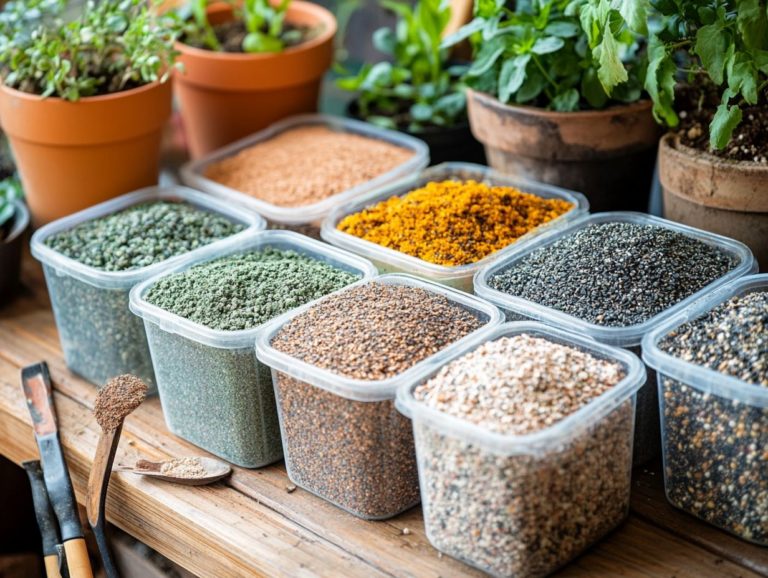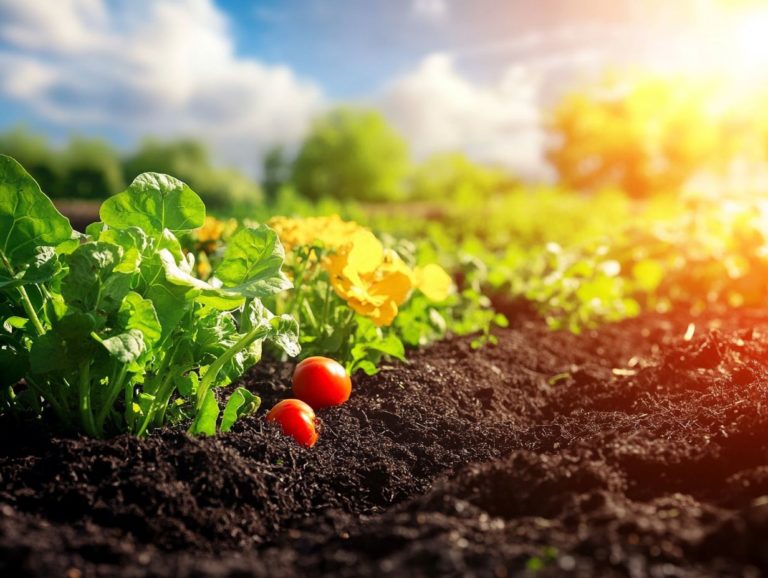Best Practices for Indoor Plant Soil Care
Caring for indoor plants involves much more than simply watering them. The right soil is essential for their health and vitality.
Selecting the perfect soil mix and understanding drainage and pH levels are critical elements that significantly influence your plants’ growth.
This guide covers essential practices, such as avoiding overwatering, managing pests effectively, and recognizing the right time to repot.
By mastering these techniques, you can transform your space and infuse it with life and beauty.
Contents
- Key Takeaways:
- 1. Choosing the Right Soil for Your Indoor Plants
- 2. Understanding the Importance of Drainage
- 3. Avoiding Overwatering
- 4. Fertilizing Indoor Plants
- 5. Dealing with Pests and Diseases
- 6. Replacing Old Soil
- 7. Using Compost for Nutrient-Rich Soil
- 8. Adjusting Soil pH Levels
- 9. Choosing the Right Container for Your Plants
- 10. Properly Watering Your Plants
- 11. Understanding the Needs of Different Types of Plants
- 12. Using Mulch to Retain Moisture
- 13. Aerating the Soil
- 14. Knowing When to Repot Your Plants
- 15. Properly Storing and Handling Soil
- Frequently Asked Questions
- What are the best practices for indoor plant soil care?
- How often should I water my indoor plant?
- Do I need to fertilize my indoor plant soil?
- How do I know if my indoor plant needs to be repotted?
- Can I reuse soil from old plants for my new indoor plants?
- What should I do if my indoor plant soil is too dry or too wet?
Key Takeaways:

- Choose the right soil for vibrant growth.
- Ensure proper drainage to prevent root rot.
- Water only when the top inch of soil is dry.
1. Choosing the Right Soil for Your Indoor Plants
Choosing the right soil for indoor plants is essential for their growth and overall health. The potting medium you select directly impacts root development, moisture retention, and nutrient levels all critical elements for thriving houseplants like tropical varieties, aroids, and succulents.
A well-crafted potting mix that includes peat moss, perlite, and organic materials can significantly enhance soil structure, making it suitable for a diverse range of indoor plants.
For example, peat moss excels at moisture retention while maintaining an ideal pH level, making it particularly beneficial for moisture-loving plants. Perlite is lightweight and boosts aeration, preventing soil compaction and allowing roots to breathe freely.
Adding components like coconut coir can further improve water retention without risking oversaturation, perfect for plants that thrive in balanced humidity environments.
By understanding these characteristics, you can customize your potting mediums to meet the specific water and nutrient needs of your plant collection, encouraging healthy growth and vibrant foliage.
2. Understanding the Importance of Drainage
Understanding the importance of drainage is crucial for maintaining the health of your indoor plants. Insufficient drainage can lead to roots becoming too crowded and disrupt moisture control, jeopardizing your beloved houseplants.
Proper drainage holes in pots are essential for allowing excess water to escape. This helps you avoid the dreaded issue of waterlogging, which can suffocate roots and encourage root rot.
The type of soil you choose plays a significant role in drainage. For instance, heavy clay soils tend to retain moisture, while sandy soils promote quick drainage.
Opting for the right potting medium, such as a blend that includes perlite or coarse sand, can significantly enhance drainage capabilities. When selecting pots, look for those with multiple drainage holes and slightly elevated bases. This design ensures that excess water flows out freely, providing your plants with the optimal environment they need to thrive.
3. Avoiding Overwatering
Avoiding overwatering is essential for nurturing your indoor plants and can greatly enhance their overall health. Excess moisture can lead to nutrient deficiencies and root rot, severely impacting their growth potential.
To ensure each of your plants thrives, create a customized watering schedule that considers the specific needs of different species. Factors like light conditions, pot size, and soil type all play a role in determining how much and how often you should water.
Keep an eye out for signs of overwatering, such as yellowing leaves or a foul odor emanating from the soil these are clear signals that adjustments are needed.
Implementing effective moisture control techniques, like using well-draining pots or checking soil moisture levels with your finger or a moisture meter, can help you strike the right balance. By familiarizing yourself with the unique hydration preferences of each plant, you can cultivate a healthier indoor garden environment. For more tips, explore the best watering techniques for indoor plants.
4. Fertilizing Indoor Plants
Fertilizing your indoor plants effectively is essential for providing them with the nutrients they need for vibrant growth and overall health. Whether you opt for organic fertilizers or synthetic options, having a comprehensive fertilizer guide is critical.
Understanding the various types of fertilizers granular, liquid, and slow-release gives you the power to choose the best option for your plants. Each type has its benefits. For example, liquid fertilizers deliver nutrients quickly but need frequent applications. On the other hand, slow-release formulas offer the convenience of less frequent feeding.
Assessing your plant’s nutrient requirements is equally vital. You can check for signs of deficiencies, such as yellowing leaves or stunted growth. Timing is critical; applying fertilizer during the growing season ensures that your plants can absorb nutrients effectively.
By balancing nutrient delivery with a mix of fertilizing techniques, you can cultivate a flourishing indoor garden that truly thrives.
5. Dealing with Pests and Diseases
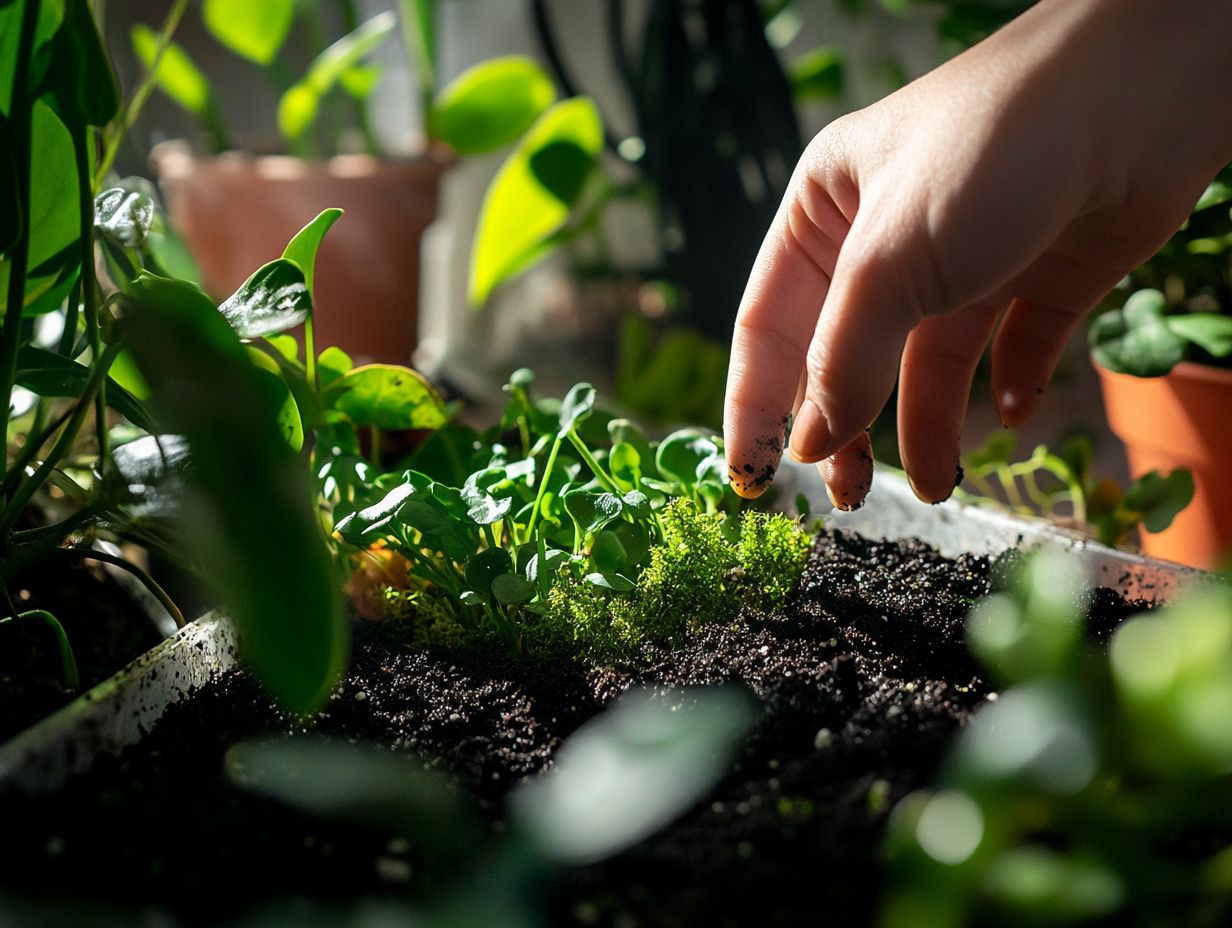
Dealing with houseplant pests and diseases is a vital part of your indoor gardening journey. Staying vigilant with effective prevention strategies can save your beloved plants from significant damage and ensure their ongoing health.
Common culprits like spider mites, aphids, and mealybugs can wreak havoc on your foliage, leading to stunted growth, discoloration, and even plant demise. If you notice yellowing leaves or sticky residue on surfaces, these are clear signs of infestations that shouldn’t be ignored. Diseases like root rot, a condition where roots start to decay due to too much water, can also affect your plants.
Regular inspections are your best ally in spotting early signs and symptoms before they escalate. For prevention, consider introducing beneficial insects or using neem oil for a more organic approach. Commercial insecticides can also provide a swift solution when the situation calls for it.
Ultimately, maintaining healthy plants hinges on your consistent monitoring and proactive stance toward pest management. Stay proactive to protect your indoor oasis!
6. Replacing Old Soil
Replacing old soil is a crucial practice for maintaining the health of your indoor plants. It revitalizes the potting medium, encourages robust root growth, and restores the essential nutrient balance.
Over time, your indoor plants may exhibit signs that they’re in urgent need of this refresh. One common indicator is root binding, where the roots become tightly coiled and begin to peek through the drainage holes, signaling that they’ve depleted the available nutrients. If you notice that the soil isn’t retaining moisture and dries out too quickly after watering, it might be time to learn about the science of watering indoor plants to make a change.
Regarding repotting, you ll want to carefully remove the plant from its current container, gently loosen any tightly bound roots, and then settle it into a fresh pot filled with high-quality soil. Enhancing your new mix with soil amendments like compost or peat moss can significantly boost its fertility and moisture retention capabilities.
7. Using Compost for Nutrient-Rich Soil
Using compost for nutrient-rich soil is a sustainable approach to enhancing the health of your houseplants. It improves soil structure, promotes nutrient balance, and encourages beneficial microbial activity.
When you incorporate compost into your potting mixes, you unlock a wealth of advantages, especially in terms of nutrient availability. It delivers essential elements like nitrogen, phosphorus, and potassium, ensuring your plants receive the nourishment they need to truly thrive.
Compost also helps retain moisture, allowing your soil to maintain adequate hydration levels and reducing the frequency of watering. If you’re interested in creating your own compost, kitchen scraps, leaves, and grass clippings can come together to form a rich, organic mix. Alternatively, sourcing high-quality compost from local garden centers guarantees optimal plant growth without the added hassle of DIY production.
8. Adjusting Soil pH Levels
Adjusting soil pH levels is vital for your plants. An improper pH can cause nutrient deficiencies and stunt growth.
Understand the ideal pH range for different indoor species. Most houseplants thrive in slightly acidic to neutral conditions, around 6.0 to 7.0.
To test soil pH, use pH test strips, electronic meters, or professional lab services. If the pH is off, add peat moss for acidity or lime for alkalinity.
Regular monitoring ensures your adjustments lead to lasting improvements.
9. Choosing the Right Container for Your Plants
Selecting the right container is key for your plants’ health and vitality. It affects drainage and room for roots to grow.
Consider the size of the pot carefully. A small pot can stifle roots, while a large one may lead to too much water.
The material matters too. Ceramic or terracotta pots offer better aeration but dry out quickly. In contrast, plastic containers retain moisture.
Don t forget drainage holes! They prevent waterlogging, which is a common problem.
10. Properly Watering Your Plants
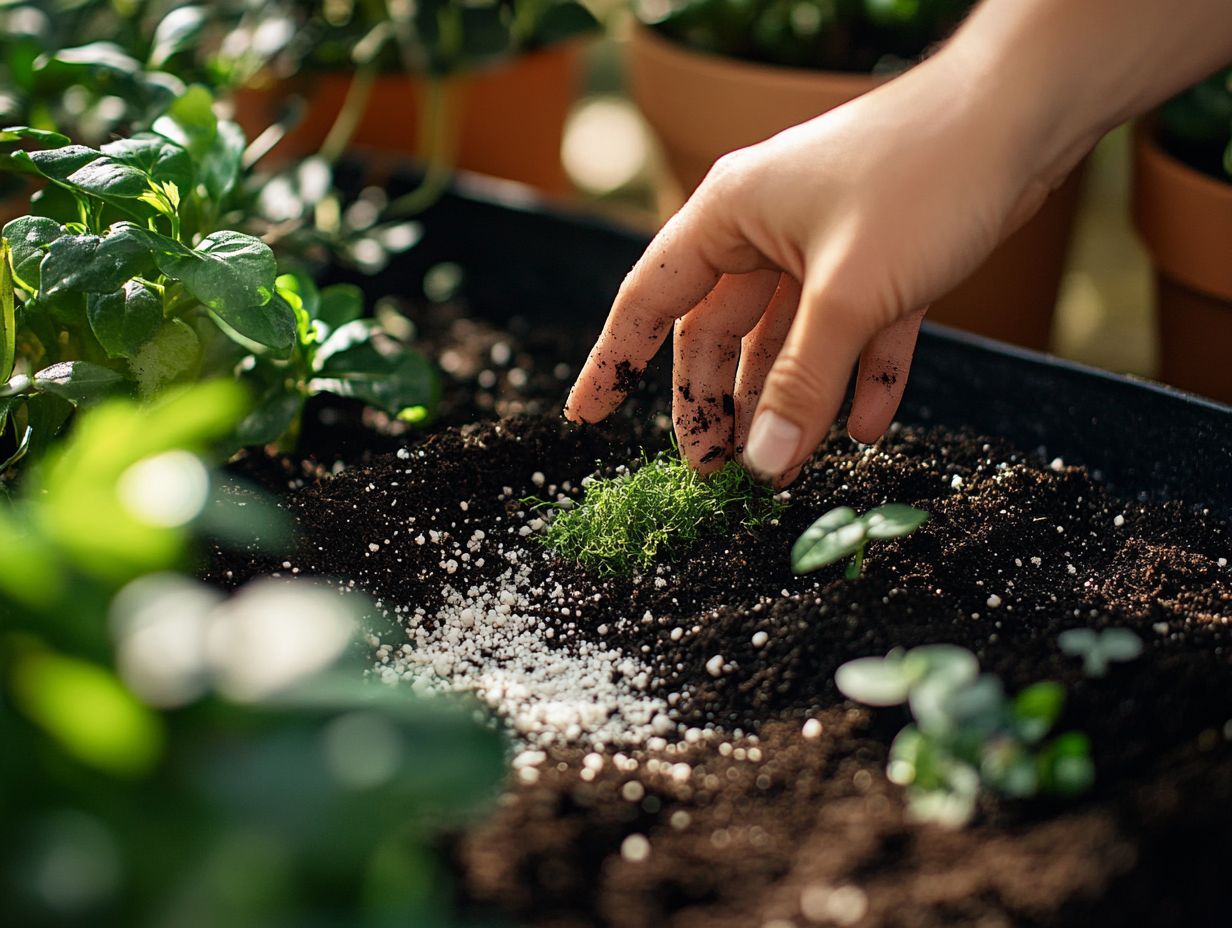
Properly watering your plants is essential. This practice can significantly improve their growth and health.
First, check the soil moisture levels. Stick your finger an inch into the soil; if it feels dry, it’s time to water.
Know your plant types. Some thrive in wetter conditions, while others prefer drier air.
Seasonal changes affect watering. In warmer months, evaporation increases, so check more frequently.
As temperatures drop, adjust to prevent giving them too much water, which can harm them.
11. Understanding the Needs of Different Types of Plants
Understanding plant needs is crucial for indoor gardening success. Light, humidity, and care requirements dictate their growth.
Start by assessing the light in your home. This ranges from bright sunlight by windows to darker corners with filtered light.
Next, check humidity levels. Some plants love moist environments, while others do better in drier air.
If you’re a beginner, choose low-maintenance varieties like snake plants or pothos. More experienced gardeners might enjoy the challenge of high-maintenance options such as orchids or ferns.
By selecting plants according to their natural preferences, you can cultivate an indoor garden that thrives!
12. Using Mulch to Retain Moisture
Using mulch to retain moisture is a brilliant strategy for caring for your indoor plants. It not only helps regulate soil temperature but also acts as a protective barrier against weeds and evaporation.
Choosing the right mulch can greatly improve your plants’ health. Organic mulches, such as shredded coconut coir or bark chips, not only trap moisture but also enrich the soil as they break down, providing important nutrients your plants crave.
Incorporating a layer of mulch can also deter pests and prevent soil compaction, creating a more favorable root environment. Apply mulch at a depth of about one to two inches, ensuring it doesn t touch the plant stems to prevent any risk of rot and decay.
13. Aerating the Soil
Aerating the soil is essential for maintaining the health of your indoor plants. It enhances soil structure, promotes air circulation, and encourages robust root growth.
This practice significantly affects nutrient uptake and water retention, giving your plants the power to thrive in their potted surroundings. Over time, soil can become compacted, restricting airflow and water movement, which can lead to unhealthy root systems.
To effectively aerate, consider employing various tools such as:
- a soil auger
- a fork
- an aeration rake
These handy instruments create small holes that allow air, nutrients, and moisture to penetrate deeper into the soil. Aerate your plants during their growing season for the best results, typically in spring or early summer, and repeating this process every few months will ensure their sustained health and vitality.
14. Knowing When to Repot Your Plants
Understanding when to repot your plants is crucial for their ongoing growth and vitality. Timely repotting promotes root development, prevents root binding, and introduces fresh potting medium that delivers essential nutrients.
Recognizing the signs that it s time for a change can truly elevate your plant care routine. Notice roots creeping through the drainage holes at the bottom of the pot or observe noticeable stunted growth. These are clear indicators that your plant is outgrowing its current home.
Other signs to keep an eye out for include wilting, even when you’ve watered adequately, or leaves turning yellow both of which can suggest that the soil has run out of nutrients.
To ensure a successful repotting experience, start by choosing a pot that’s one size larger than the current one, making sure it has ample drainage holes. Gently lift the plant from its old pot, being careful not to damage the roots, and loosen any tightly bound roots to promote healthy growth. Compacted soil means it has become too dense for air and water to move through. For better moisture management, consider applying watering techniques for different indoor species. Add a layer of fresh soil to the new pot, position your plant inside, and then fill in with more soil to secure it, leaving a bit of space at the top to prevent overflow during watering.
Finally, give your plant a generous drink to help it settle into its new abode.
15. Properly Storing and Handling Soil
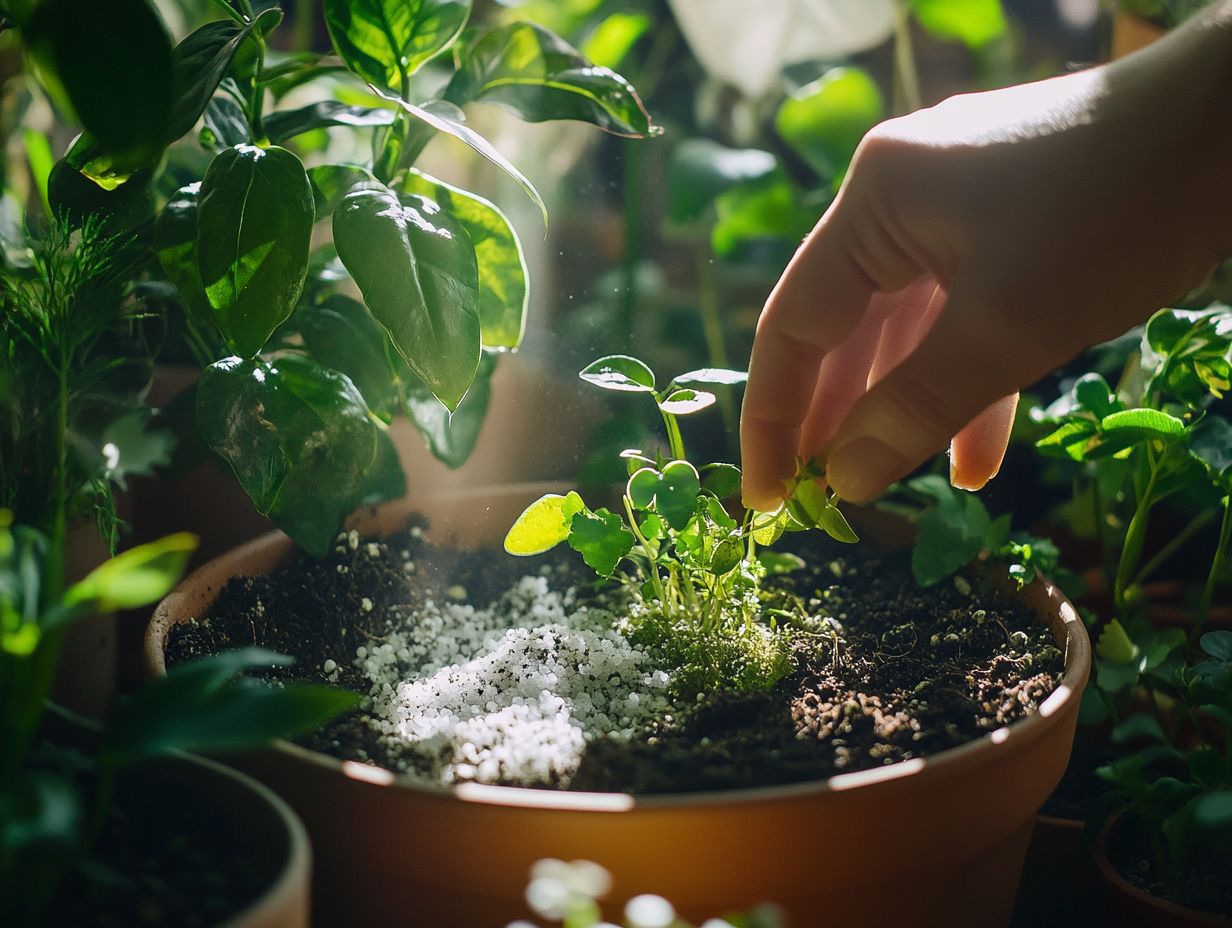
Properly storing and handling soil is crucial for maintaining its quality and effectiveness in nurturing your indoor plants. Neglecting this can lead to moisture loss and the degradation of different soil types.
To create optimal conditions, ensure that your soil is kept in a moisture-controlled environment, far from direct sunlight and extreme temperatures. This approach not only preserves essential nutrients but also wards off the growth of harmful organisms. Additionally, choosing the right water for indoor plants can further enhance their health and growth.
When you’re potting or repotting, remember to use clean tools to prevent any contamination. Gently loosen any compacted areas without disturbing the overall structure; this will keep the soil healthy and aerated. Using breathable containers can further enhance airflow, promoting soil vitality.
By following these best practices, you ll ensure your soil remains in excellent condition, ready to support thriving plants.
Frequently Asked Questions
What are the best practices for indoor plant soil care?
The best practices for indoor plant soil care include using well-draining potting soil, watering regularly but not overwatering, and fertilizing as needed.
Ready to elevate your indoor gardening skills? Start applying these tips today!
How often should I water my indoor plant?
Watering frequency depends on the type of plant, humidity, and temperature. Check the soil moisture before watering; water only when the top inch is dry.
Do I need to fertilize my indoor plant soil?
Indoor plants love a bit of fertilizer! Use a diluted liquid fertilizer every 2-4 weeks during their growing season.
How do I know if my indoor plant needs to be repotted?
Repot your plant if it has outgrown its pot or roots are pushing through small holes at the bottom. If it’s wilting often or the soil dries out too quickly, it might need a larger pot.
Can I reuse soil from old plants for my new indoor plants?
It’s best not to reuse soil from old plants. Old soil can harbor pests and diseases that harm new plants. Always use fresh, sterilized potting soil!
What should I do if my indoor plant soil is too dry or too wet?
If the soil is too dry, water it well and ensure excess water can drain out. For wet soil, take the plant out of its pot, shake off the extra soil, and repot it with fresh, well-draining soil.


